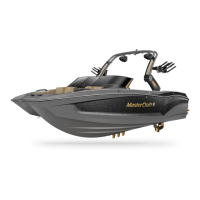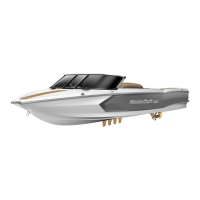mastercraft 2010 ow n e r ’s m anual • page 1-7
In other situations when entry into cold water is necessary:
• Wear a PFD.
• Button all clothing.
• Cover your head if possible and enter the water slowly.
• Keep your head out of the water if at all possible.
• Assume the Heat Escape Lessening Posture (HELP) position as
taught within a Coast Guard-taught safety course.
Hypothermia
Immersion in water speeds the loss of body heat and can lead to
hypothermia. This is the abnormal lowering of internal body tempera-
ture. If a boat capsizes it will likely oat on or just below the surface.
To reduce the effects of hypothermia, get in or on the boat. Try to
get as much of your body out of the water as possible. If you can’t get
in the boat, a PFD will enable you to keep your head out of the water.
This is very important because about 50 percent of body heat loss is
from the head.
It may be possible to revive a drowning victim who has been un
-
der water for some time and shows no sign of life. Cases document
instances where victims have been resuscitated after extended peri-
ods. Start CPR immediately and get the victim to a hospital as quickly
as possible.
Immersion Suits
Immersion suits will delay the effects of hypothermia in cold wa-
ter and are available through many retailers who specialize in sales of
marine products. The suits should be stored and maintained according
to the manufacturer’s instructions.
Inflatable Life Rafts
An inatable life raft can provide a survival platform for an ex-
tended period of time. Be sure the life raft is large enough for every-
one on board when the boat operates off-shore. It should have the
appropriate emergency equipment pack and should be professionally
serviced periodically, according to the manufacturer’s instructions.
Coast Guard-approved life rafts must meet a number of stringent ma-
terial and performance standards.
Anchoring
Anchoring is done for two principal reasons: rst, to stop for sh-
ing, swimming, lunch or an overnight stay, and secondly, to keep a boat
from running aground in bad weather or as a result of engine failure.
When preparing to anchor, bring the bow of the vessel into the
wind or current. Place the engine in neutral. When the boat comes to
a stop, slowly lower the anchor. Do not throw the anchor over as it
will tend to foul the anchor or tangle line. When the anchor line has
been let out, back down on the anchor with the engine in idle reverse
to help set the anchor. After it is rmly set, use reference points (land-
marks) in relation to the boat to be sure that the boat is not drifting.
Check the points frequently.
Communications
The following applies to salt water boating:
When boating off-shore, carry communications gear such as a
marine VHF-FM and/or HF transceiver(s), appropriate to the operat-
ing area. Cellular phone coverage is available in many coastal areas.
However, cellular phones should NOT be considered a substitute for
VHF-FM marine band radios for emergency purposes.
Satellite EPIRBs (406 MHz) are designed to quickly and reliably
alert rescue forces, indicate an accurate distress position, and guide
rescue units to the distress scene, even when all other communica-
tions fail.
When activated, the satellite EPIRB transmits a distress signal
with a beacon-unique identifying code. The system detects the signal,
calculates an accurate distress position, checks the unique identifying
code against the EPIRB registration database (vessel and point of con-
tact information supplied by the owner) and routes the distress alert
with registration information to the responsible U.S. Coast Guard (or
International) Rescue Coordination Center (RCC). 406MHz EPIRBs
with GPS (internal or attached) also provide an immediate GPS posi-
tion in the information passed to the RCC.
Geostationary satellites make detection almost immediate. If
the EPIRB does not have the ability to provide a GPS position, the
process to determine a position takes about an hour on average and
almost always less than two hours. Satellite EPIRBs also include a
homing beacon and strobe to help rescue forces quickly locate the
distress scene.
Satellite beacons have signicant coverage, alerting timeliness,
position accuracy, and signaling advantages over other types of
EPIRBs (121.5 MHz). Before purchasing or using something other
than the 406 MHz EPIRB, be sure to understand the capabilities and
limitations.
In distress situations, press the transmit button and clearly say:
MAYDAY, MAYDAY, MAYDAY. Follow this with the vessel name and/or
description, the location, nature of emergency and number of people
on-board. Then release the transmit button and wait for 10 seconds. If
there is no response, repeat the MAYDAY call.
Further information and a complete listing of VHF channels and
frequencies is available at: www.navcen.uscg.gov.
Law Enforcement
A vessel underway, when hailed by a Coast Guard vessel is re-
quired to heave to, or maneuver in such a manner that permits a
boarding ofcer to come aboard.
Other federal, state and local law enforcement ofcials may board
and examine a vessel. The Coast Guard may impose a civil penalty up
to $1,000 for failure to comply with equipment requirements; report
a boating accident; or comply with other federal regulations. Failure
to comply with the Inland Navigation Rules Act of 1980 can result in
a civil penalty up to $5,000. Details of the Act are available online or
through the U.S. Coast Guard and the Coast Guard Auxiliary.
Improper use of a radio-telephone is a criminal offense. The use of
obscene, indecent or profane language during radio communications
is punishable by a $10,000 ne, imprisonment for two years or both.
Other penalties exist for misuse of a radio, such as improper use of
Channel 16 VHF-FM. Channel 16 is a calling and distress channel. It is
not to be used for conversation or radio checks. Such communications
should be conducted on an authorized channel.
Note that there are stringent requirements regarding, pollution,

